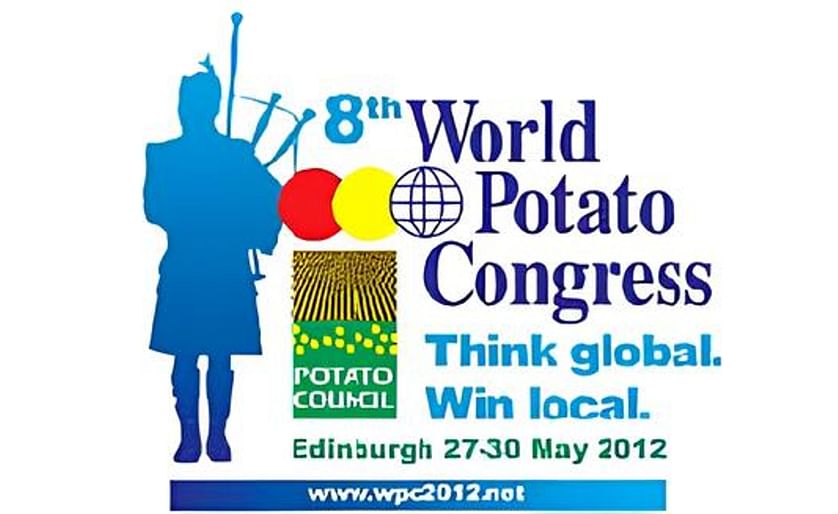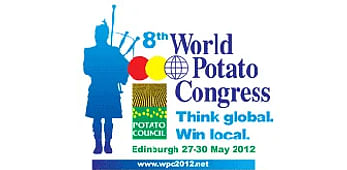World Potato Congress
War on waste in the potato supply chain

Several key actions to drive out waste from the potato supply chain, including improved agronomy, were outlined at the recent World Potato Congress in Edinburgh.
Organised by Potato Council, the event attracted more than 900 delegates and included speakers from across the globe, providing a unique opportunity for the whole industry to share information and uncover new knowledge.
A workshop featuring Dr Simon Bowen from Solanum, part of Produce World and Alan Wilson from Waitrose proved a strong draw, presenting findings from the War on Waste project being carried out by the two companies.
The five-year project started in 2008 with 30 growers in a bid to reduce waste, to allow growers, packer and retailer to benefit from improved efficiencies. With 42 per cent of tubers grown for Waitrose never appearing on the shelves there were plenty of efficiencies to be had, said Simon.

Simon Bowen speaking at the World Potato Congress (Photo Credits: Sean Bell)
“Few tubers actually end up in landfill. But top growers commit large sums of money to seed, inputs and their best land to grow crops for Waitrose, so downgraded tubers are regarded as waste, both physically and in terms of income.”
About half the losses occurred directly on farm. Some 6 per cent were failed at field level before or soon after lifting began, due to size, quality or bruising problems. Defects removed during initial grading, including damaged, mis-shapen, scabbed and green tubers, resulted in a further 12 per cent loss while storage waste accounted for 5 per cent. During packing, size grading took out 2 per cent while post-washing defects removed 22 per cent.
The project set an overall waste reduction target of 12 per cent and several key drivers were established to deliver it, including improved crop programming, better packhouse scheduling and improved retail planning.
“This requires a high level of discussion and flexibility involving all parties,” said Simon. “It involves detailed linking of grower tonnages to predicted sales volume, putting particular focus on start and finish of UK and import seasons, re-examining optimum variety profile and regular reporting against plans.”
A key additional area was an agronomic plan to tackle wastage, focusing on three key areas – soil, seed and water.
“Many defects are due to soils,” said Simon. “They may be inherently unsuitable, harbour pests or have poor moisture retentiveness.” The best soils typically saved 10-40 per cent on cultivation and input bills while producing a 15 per cent improvement in packing out-turn, he added.
“We need to consider extending or following a different rotation, introducing brassica or green manure crops. Better crop programming will also help, as will raising organic matter levels and exploring bio-control options for PCN.”
Seed needed to be integrated with ware programmes to improve quality. “We must engage more seed producers so they know what is required. This may be lower bacterial loadings where long-term storage is planned. More attention is required to optimise tuber size distribution through physiological and chronological ageing.”
Better use of water was key. Fewer crops should be targeted where irrigation was limited rather than risking wholesale rejection, he explained. Changing variety profile and increasing water reserves would also help.
“Greater attention to irrigation scheduling is also important. Rainguns must be phased out as they are very variable and wasteful – replacing with drip irrigation typically increases yields 5-10 per cent.”
Harvest actions included ridge rolling to reduce greening. Using impactors identified bruising early, and rapid store loading and cooling and block-storing to minimise disturbance when unloading would reduce storage losses.
So far damage among the grower group has fallen by 6 per cent, half the target figure. “It seems unlikely we’ll hit the target this season. However, the project’s focus will help growers serious about growing a quality product succeed, and I believe we can cut waste to 30 per cent in the next two years,” said Simon.
Key causes of waste:
Field failure
• Unsuitable soils
• Lack of irrigation
• Pests and disease
• Unsuitable soils
• Lack of irrigation
• Pests and disease
Gross defects
• Over/under size
• Mis-shapes
• Greens
• Damage
• Over/under size
• Mis-shapes
• Greens
• Damage
Storage
• Skin disease
• Weight loss
• Loss of skin brightness
• Skin disease
• Weight loss
• Loss of skin brightness
Post-washing loss
• Greens
• Damage
• Skin disease






